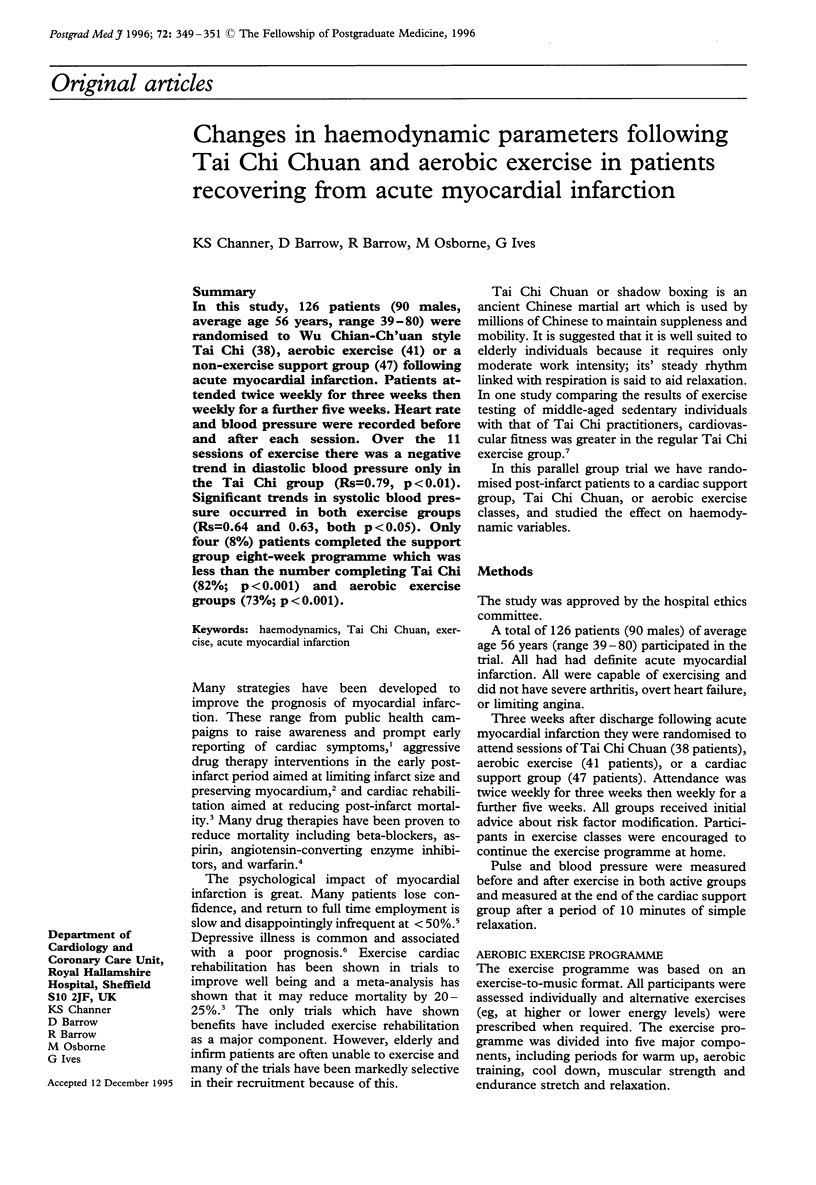Changes in haemodynamic parameters following Tai Chi Chuan and aerobic exercise in patients recovering from acute myocardial infarction (original) (raw)
Abstract
In this study, 126 patients (90 males, average age 56 years, range 39-80) were randomised to Wu Chian-Ch'uan style Tai Chi (38), aerobic exercise (41) or a non-exercise support group (47) following acute myocardial infarction. Patients attended twice weekly for three weeks then weekly for a further five weeks. Heart rate and blood pressure were recorded before and after each session. Over the 11 sessions of exercise there was a negative trend in diastolic blood pressure only in the Tai Chi group (Rs = 0.79, p < 0.01). Significant trends in systolic blood pressure occurred in both exercise groups (Rs = 0.64 and 0.63, both p < 0.05). Only four (8%) patients completed the support group eight-week programme which was less than the number completing Tai Chi (82%; p < 0.001) and aerobic exercise groups (73%; p < 0.001).

Selected References
These references are in PubMed. This may not be the complete list of references from this article.
- Channer K. S. Choosing drugs for secondary prevention after myocardial infarction: a pragmatic approach. Postgrad Med J. 1995 Jun;71(836):321–322. doi: 10.1136/pgmj.71.836.321. [DOI] [PMC free article] [PubMed] [Google Scholar]
- Goble A. J., Hare D. L., Macdonald P. S., Oliver R. G., Reid M. A., Worcester M. C. Effect of early programmes of high and low intensity exercise on physical performance after transmural acute myocardial infarction. Br Heart J. 1991 Mar;65(3):126–131. doi: 10.1136/hrt.65.3.126. [DOI] [PMC free article] [PubMed] [Google Scholar]
- Lai J. S., Wong M. K., Lan C., Chong C. K., Lien I. N. Cardiorespiratory responses of Tai Chi Chuan practitioners and sedentary subjects during cycle ergometry. J Formos Med Assoc. 1993 Oct;92(10):894–899. [PubMed] [Google Scholar]
- Mittleman M. A., Maclure M., Tofler G. H., Sherwood J. B., Goldberg R. J., Muller J. E. Triggering of acute myocardial infarction by heavy physical exertion. Protection against triggering by regular exertion. Determinants of Myocardial Infarction Onset Study Investigators. N Engl J Med. 1993 Dec 2;329(23):1677–1683. doi: 10.1056/NEJM199312023292301. [DOI] [PubMed] [Google Scholar]
- O'Connor G. T., Buring J. E., Yusuf S., Goldhaber S. Z., Olmstead E. M., Paffenbarger R. S., Jr, Hennekens C. H. An overview of randomized trials of rehabilitation with exercise after myocardial infarction. Circulation. 1989 Aug;80(2):234–244. doi: 10.1161/01.cir.80.2.234. [DOI] [PubMed] [Google Scholar]
- Rowley J. M., Hill J. D., Hampton J. R., Mitchell J. R. Early reporting of myocardial infarction: impact of an experiment in patient education. Br Med J (Clin Res Ed) 1982 Jun 12;284(6331):1741–1746. doi: 10.1136/bmj.284.6331.1741. [DOI] [PMC free article] [PubMed] [Google Scholar]
- Shanfield S. B. Return to work after an acute myocardial infarction: a review. Heart Lung. 1990 Mar;19(2):109–117. [PubMed] [Google Scholar]
- Silverstone P. H. Depression and outcome in acute myocardial infarction. Br Med J (Clin Res Ed) 1987 Jan 24;294(6566):219–220. doi: 10.1136/bmj.294.6566.219-a. [DOI] [PMC free article] [PubMed] [Google Scholar]
- Todd I. C., Ballantyne D. Antianginal efficacy of exercise training: a comparison with beta blockade. Br Heart J. 1990 Jul;64(1):14–19. doi: 10.1136/hrt.64.1.14. [DOI] [PMC free article] [PubMed] [Google Scholar]